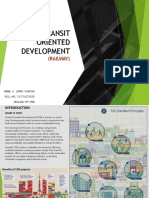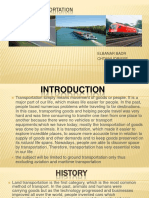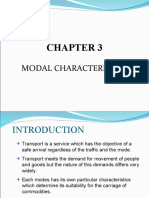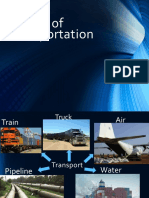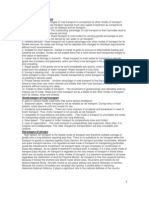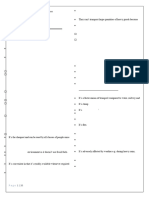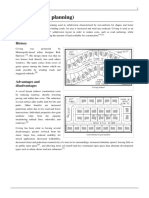1672223250_114_72753ERR
1672223250_114_72753ERR
Uploaded by
Bamadridista TVCopyright:
Available Formats
1672223250_114_72753ERR
1672223250_114_72753ERR
Uploaded by
Bamadridista TVCopyright
Available Formats
Share this document
Did you find this document useful?
Is this content inappropriate?
Copyright:
Available Formats
1672223250_114_72753ERR
1672223250_114_72753ERR
Uploaded by
Bamadridista TVCopyright:
Available Formats
RAIL TRANSPORTATION
Rail transport is also known as train transport. Rail transport is a means of transport where
people and goods are transported on wheeled vehicles running on rails which are located
on tracks compared to road transport, which mainly runs on a prepared surface. It is the
most cost-effective mode of commuting and goods carriage over long as well as short distances on
land.
The tracks are smooth and hard surfaces on which the wheels of the train can roll with a relatively low
level of friction being generated.
The Global Rail Network
The global rail network, which is mostly a collection of unlinked national rail systems,
involves three main types of rail lines:
Penetration Line: To link a port city with its hinterland, particularly to access natural
resources such as minerals, agriculture products, and wood products. The main purpose is to
convey large amounts of materials in a manner that would be prohibitive for road transport. It is
mainly found in developing countries like Africa and Latin America and was partially the result
of the colonial era. From the Mpumalanga region, 80% of South Africa’s coal comes, which is
about 590 km from the port of Richards Bay. Coal trains are used to carry coal from mines to
the port.
Regional Network: The regional networks are effectively the coming together of groups in an
area who are engaged in Transition. There are both benefits to doing this and challenges,
ultimately regional networks have to be beneficial not a burden. Regions with the highest rail
density are Western Europe, the North-Eastern part of North America, Coastal China, and Japan.
Transcontinental Lines: It is mainly established to improve territorial accessibility and for the
setting of national sovereignty. The examples are in the United States, Canada, Russia, and
© 2022 Athena Global Education. All Rights Reserved
Australia, which have built rail systems of this scale, such as between New York and Los
Angeles, across Eurasia (between Dalian and Moscow), across Southern Australia (Perth and
Adelaide) or across South America (Buenos Aires and Valparaiso).
Advantages of Rail Transport
Dependable: It is the most dependable mode of transport. It is least affected by weather
conditions such as rain, fog, etc.
Better Organized: It is better organized than any other form of transport. It has fixed routes
and schedules.
High Speed Over Long Distances: Its speed over long distances is more than any other
mode of transport, except airways.
Suitable for Bulky and Heavy Goods: It is economical, quicker, and best suited for carrying
heavy and bulky goods over long distances.
Cheaper Transport: It is a cheaper mode of transport. Most of the working expenses of
railways are in the nature of fixed costs. Every increase in railway traffic is followed by a
decrease in the average cost. Rail transport is economical in the use of labor also as one driver
and one guard are sufficient to carry much more load than motor transport.
Safety: The railway is the safest form of transport, and the chances of accidents and
breakdowns of railways are minimal. The traffic can be protected from exposure to the sun,
rain, snow, etc.
Larger Capacity: The carrying capacity of the railways is extremely large, its capacity is
elastic which can easily be increased by adding more wagons.
Disadvantages of Rail Transport
Huge Capital Outlay: The railway requires a large investment of capital. The cost of
construction, maintenance, and overhead expenses are very high as compared to other modes
of transport. The investments are specific and immobile. In case the traffic is not sufficient, the
investments may mean the wastage of huge resources.
Lack of Flexibility: Its routes and timings cannot be adjusted to individual requirements.
Lack of Door-to-Door Service: Rail transport cannot provide door-to-door service as it is tied
to a particular track. Intermediate loading or unloading involves greater cost, more wear and
tear, and a wastage of time. The time and cost of terminal operations are a great disadvantage
of rail transport.
Monopoly: As railways require huge capital outlay, they may give rise to monopolies and work
against the public interest at large. Even if controlled and managed by the government, lack of
competition may breed inefficiency and high costs.
Unsuitable for Short Distance and Small Loads: Railway transport is unsuitable and
uneconomical for a short distances and small traffic of goods.
Booking Formalities: It involves much time and labor in booking and taking delivery of goods
through railways as compared to motor transport.
No Rural Service: Because of huge capital requirements and traffic, railways cannot be
operated economically in rural areas. Thus, rural areas have no railway service even today. This
caused much inconvenience to the people living in rural areas.
Under-Utilized Capacity: The railway must have a full load for its ideal and economic
operation. As it has a very large carrying capacity, under-utilization of its capacity, in most of
the regions, is a great financial problem and loss to the economy.
Centralized Administration: Being the public utility service, railways have a monopoly
© 2022 Athena Global Education. All Rights Reserved
position and as such, there is centralized administration. Local authorities fail to meet the
personal requirements of the people as compared to roadways.
© 2022 Athena Global Education. All Rights Reserved
You might also like
- Modes of TransportationDocument6 pagesModes of TransportationJeet100% (1)
- Assess The Advantages and Disadvantages of Road, Rail, Air and Water Transport Within or Outside Pakistan For Both Goods and PeopleDocument10 pagesAssess The Advantages and Disadvantages of Road, Rail, Air and Water Transport Within or Outside Pakistan For Both Goods and PeopleSalman Farsi100% (8)
- Chapter 2 TransportationDocument27 pagesChapter 2 TransportationAhmed HonestNo ratings yet
- Inter City & Intra City TrafficDocument11 pagesInter City & Intra City TrafficDebanshu Payra100% (2)
- Wheels and Tyres PPT 2Document20 pagesWheels and Tyres PPT 2Arnav Naula100% (1)
- Thesis Synopsis: Transit Oriented DevelopmentDocument6 pagesThesis Synopsis: Transit Oriented DevelopmentOmar FarookNo ratings yet
- Highway and Railroad EngineeringDocument50 pagesHighway and Railroad EngineeringJessie Jade DurojaNo ratings yet
- RAILWAYS AND MASS TRANSIT SYSTEM Assignmet-01 (CE-1007)Document4 pagesRAILWAYS AND MASS TRANSIT SYSTEM Assignmet-01 (CE-1007)MD. SHUVO RAHMANNo ratings yet
- Advantages&Disadvantages of RailwayDocument3 pagesAdvantages&Disadvantages of RailwayDarwin BasNo ratings yet
- TRAFFIC QUESTIONNAIRE SURVEY AnswerDocument7 pagesTRAFFIC QUESTIONNAIRE SURVEY AnswerDEEKSHI ANGELIKKA MNo ratings yet
- Advantages Disadvantages RailwayDocument1 pageAdvantages Disadvantages RailwaymurungirakeeliNo ratings yet
- Module 1Document30 pagesModule 1nidhi frootyNo ratings yet
- Module 1Document29 pagesModule 1SR TalkiesNo ratings yet
- Land Transportation: Elbanar Badr Chtaini IdrisseDocument19 pagesLand Transportation: Elbanar Badr Chtaini IdrissematrixleblancNo ratings yet
- Transportation Notes Class 10 ICSEDocument4 pagesTransportation Notes Class 10 ICSEzoha afshan71% (7)
- TransportDocument7 pagesTransportBikramjit MajumdarNo ratings yet
- Class Activity-202104121-Vipul TyagiDocument6 pagesClass Activity-202104121-Vipul TyagiVipul TyagiNo ratings yet
- chp3 - Modal Characteristics-1-1Document48 pageschp3 - Modal Characteristics-1-1Wiwie NurNo ratings yet
- Strength WeaknessDocument9 pagesStrength WeaknessNadarajan PerumalNo ratings yet
- Transportation Engg - II Lectures-Unit 1Document55 pagesTransportation Engg - II Lectures-Unit 1Ajey TripathiNo ratings yet
- Chapter Two: Modes of TransporationDocument24 pagesChapter Two: Modes of Transporationassefa horaNo ratings yet
- Highway Engineering Cv0503 Unit 1Document18 pagesHighway Engineering Cv0503 Unit 1gopal palNo ratings yet
- Road Engineering Assignment CDocument28 pagesRoad Engineering Assignment Cmalikarslan536No ratings yet
- Technical, Operational and Commercial CharacteristicsDocument11 pagesTechnical, Operational and Commercial CharacteristicsrbhavishNo ratings yet
- Rail FreightDocument8 pagesRail Freight5s76458rdcNo ratings yet
- Geography AssignmentDocument10 pagesGeography AssignmentPrithiviNo ratings yet
- Lect 2 NDocument15 pagesLect 2 NAhmad MohammadNo ratings yet
- Transport QuizDocument4 pagesTransport QuizTosif ur RehmanNo ratings yet
- CE120Document6 pagesCE120ronoroaNo ratings yet
- 7 - Transport & CommunicationDocument21 pages7 - Transport & Communicationtobit6182No ratings yet
- Land TranspoDocument2 pagesLand TranspoAna PatriciaNo ratings yet
- CH-2 MCLMDocument7 pagesCH-2 MCLMyulianandualemNo ratings yet
- L-25 Transport Communication and Trade in IndiaDocument24 pagesL-25 Transport Communication and Trade in IndiaMeghana ReddyNo ratings yet
- Benefits and ChallengesDocument2 pagesBenefits and Challengessijinjoseph111No ratings yet
- Classification of ProductDocument8 pagesClassification of ProductOnyejelem AmarachiNo ratings yet
- TRANSPORT Edited Aug 2021Document10 pagesTRANSPORT Edited Aug 2021zainab zeinNo ratings yet
- Pak Studies Unit 9 - 9thDocument17 pagesPak Studies Unit 9 - 9thhajra.danish17No ratings yet
- Transport and CommunicationkeDocument11 pagesTransport and Communicationkeaaronnjugi412No ratings yet
- BECM 4201 Transportation Engineering in ConstructionDocument76 pagesBECM 4201 Transportation Engineering in ConstructionAkib IslamNo ratings yet
- GROUP 2-TRANSPORTATION-AS-A-SYSTEMDocument16 pagesGROUP 2-TRANSPORTATION-AS-A-SYSTEMAlvie Grace ClaritoNo ratings yet
- Railway EngineeringDocument102 pagesRailway EngineeringHimanshu GuptaNo ratings yet
- 2.0 Physical Components - PPT Tpt250Document97 pages2.0 Physical Components - PPT Tpt250Nur Athirah Muhamad SobriNo ratings yet
- Modes of TransportationDocument15 pagesModes of TransportationVictorNo ratings yet
- Geometric DesignDocument174 pagesGeometric DesignamdaNo ratings yet
- MOSHI CO-OPERAT-WPS OfficeDocument8 pagesMOSHI CO-OPERAT-WPS OfficeYvonne SapulNo ratings yet
- Road Transport AdvantagesDocument3 pagesRoad Transport AdvantagesKetan DeshmukhNo ratings yet
- 21 Ce 22Document6 pages21 Ce 22fasi kakarNo ratings yet
- News LetterDocument4 pagesNews Letterpradnya.adhav23No ratings yet
- FORM 4 GEOG NOTES 2...Mr.MasindeDocument20 pagesFORM 4 GEOG NOTES 2...Mr.MasinderaralwavessolutionsNo ratings yet
- Lecture 1-2 - ECE 3101Document34 pagesLecture 1-2 - ECE 3101Zaituni SuleimanNo ratings yet
- Class 10 Social Science Geography Ch-7Document9 pagesClass 10 Social Science Geography Ch-7todiwov781No ratings yet
- Rema 101Document25 pagesRema 101Cyril Jean GulmaticoNo ratings yet
- Highway and Railroad Engineering Part 1&2Document7 pagesHighway and Railroad Engineering Part 1&2MarycorNo ratings yet
- Lesson 1 CCE 2225 Transportation Planning & DevelopmentDocument32 pagesLesson 1 CCE 2225 Transportation Planning & DevelopmentDeAndre mtekoNo ratings yet
- Land Transportation Lesson 3Document23 pagesLand Transportation Lesson 3Akira PajulasNo ratings yet
- Railway and Tunnel Construction Teaching ModuleDocument63 pagesRailway and Tunnel Construction Teaching Modulemustafe cali salebanNo ratings yet
- 3 - Modes of TransportationDocument20 pages3 - Modes of TransportationPenelope MalilweNo ratings yet
- FORM 4 GEOG NOTES 2...Mr.MasindeDocument21 pagesFORM 4 GEOG NOTES 2...Mr.MasinderaralwavessolutionsNo ratings yet
- Group 1Document38 pagesGroup 1Arianne Rose MamelocoNo ratings yet
- Railway and Tunnel Construction Teaching ModuleDocument61 pagesRailway and Tunnel Construction Teaching Modulemustafe cali salebanNo ratings yet
- Pradhan Mantri Gram Sadak Yojana, 2016-17: Cost Estimate For Road WorksDocument6 pagesPradhan Mantri Gram Sadak Yojana, 2016-17: Cost Estimate For Road WorksHoque joynul100% (1)
- Pulsar Ns200Document39 pagesPulsar Ns200Wan Fauzan100% (1)
- Anggita API 1102 01Document22 pagesAnggita API 1102 01Luqmanul HakimNo ratings yet
- Analysis and Design of High Rise Building Frames Staad ProDocument6 pagesAnalysis and Design of High Rise Building Frames Staad ProSanket PatelNo ratings yet
- Learning Objective: Understand The Application of Frictional ForceDocument19 pagesLearning Objective: Understand The Application of Frictional ForceAileen PoLyNo ratings yet
- 1994 Codified OrdinanceDocument257 pages1994 Codified OrdinanceJonahNo ratings yet
- CovingDocument3 pagesCovingAthzirys VillegasNo ratings yet
- Task One: Paragraph Headings (10 Minutes) - Questions 1-6Document2 pagesTask One: Paragraph Headings (10 Minutes) - Questions 1-6BenceNo ratings yet
- 968 Club SportDocument5 pages968 Club SportJeff ChinNo ratings yet
- Cable Laying SpecificationDocument16 pagesCable Laying SpecificationdavidgarciavazquezNo ratings yet
- Eastern SamarDocument5 pagesEastern SamarJO EYNo ratings yet
- 2016 Indiana Driver's ManualDocument55 pages2016 Indiana Driver's ManualPanthrosNo ratings yet
- June 22-2015 - Monday - Update - Appendix 1 - Raf FC Finding AidsDocument24 pagesJune 22-2015 - Monday - Update - Appendix 1 - Raf FC Finding AidsTed BeaudoinNo ratings yet
- HRTC Print TicketDocument2 pagesHRTC Print Ticketabcd_1234250% (1)
- Vissim Basics 1 PDFDocument17 pagesVissim Basics 1 PDFumairNo ratings yet
- SS GEO - G8-Geography-Term-4-ExamDocument16 pagesSS GEO - G8-Geography-Term-4-ExamEstelle EsterhuizenNo ratings yet
- Am Jinka Highway Project, EthiopiaDocument160 pagesAm Jinka Highway Project, EthiopiaAbel MelakuNo ratings yet
- RRLDocument1 pageRRLMark LogmaoNo ratings yet
- Automobile Chassis and Frame ChassisDocument7 pagesAutomobile Chassis and Frame ChassisAmal MechanicNo ratings yet
- Government of Tamilnadu: Registration DepartmentDocument13 pagesGovernment of Tamilnadu: Registration DepartmentManiNo ratings yet
- DPR-Dtd09-03-24-Pkg XIV-VMEDocument2 pagesDPR-Dtd09-03-24-Pkg XIV-VMERaj Kumar SinghNo ratings yet
- Kenworth T680 Operator's ManualDocument403 pagesKenworth T680 Operator's ManualEbodio Guevara100% (1)
- PRDP Su - FMR Fs OutlineDocument9 pagesPRDP Su - FMR Fs OutlineForonline GamingNo ratings yet
- AsphaltDocument12 pagesAsphaltjitendraNo ratings yet
- Dot 60711 DS1Document29 pagesDot 60711 DS1talbeoNo ratings yet
- TSRTC Bus PassDocument2 pagesTSRTC Bus PassAfnan AhmedNo ratings yet
- U.P PLANNING FINAL-ModelDocument1 pageU.P PLANNING FINAL-ModelAnshu SinghNo ratings yet
- Angolia, William - Charging Documents - April 2017Document3 pagesAngolia, William - Charging Documents - April 2017stevennelson10No ratings yet





